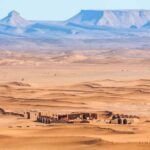
Top Desert Photography Tips for Capturing the Beauty of Chegaga
The Chegaga Desert, with its sweeping sand dunes, vast landscapes, and dramatic light shifts, offers a photographer’s dream. Whether you’re a seasoned photographer or someone just looking to capture the stunning beauty of the desert on your phone, Chegaga provides countless opportunities to take breathtaking photos. However, photographing the desert landscape comes with its own set of challenges, such as the intense light, shifting sand, and expansive horizons. To help you capture the desert’s awe-inspiring beauty, here are some essential desert photography tips for shooting in the Chegaga Desert.
1. Understand the Golden Hours
The Chegaga Desert is most beautiful during the “golden hours”—the periods shortly after sunrise and just before sunset. The light during these times is softer, warmer, and less harsh than midday sunlight, which can create harsh shadows and overexposed highlights. During the golden hours, the sand dunes take on a glowing, almost magical quality, and the long shadows create depth and texture in your shots.
Tip: Aim to wake up early for sunrise and stay out for sunset to make the most of these precious moments of soft, flattering light. The Chegaga Desert offers some of the most spectacular views during these hours, perfect for capturing dynamic and dramatic photos.
2. Experiment with Sand Dune Textures
One of the standout features of the Chegaga Desert is its massive sand dunes, which change shape and texture as the wind shifts the sand. When photographing dunes, focus on capturing their texture by playing with the light and shadows. The dunes create interesting lines, curves, and patterns, especially when lit from the side during the early morning or late afternoon.
Tip: Look for interesting contrasts between light and shadow to create a sense of depth in your photos. Zoom in on the patterns in the sand or find unique angles to show the sweeping curves of the dunes.
3. Use a Wide-Angle Lens
To capture the vastness of the Chegaga Desert, a wide-angle lens is a must. The desert is expansive, and you’ll want to convey its enormity in your photos. A wide-angle lens allows you to capture sweeping landscapes, massive dunes, and dramatic skies in a single frame. This type of lens is also excellent for capturing the unique shapes and patterns of the desert’s features.
Tip: When using a wide-angle lens, be mindful of the composition. Include elements like the horizon or a silhouette in the foreground to create balance and draw the viewer’s eye into the frame.
4. Capture the Night Sky
The Chegaga Desert offers some of the best stargazing in Morocco, thanks to its remote location and lack of light pollution. The night sky in the desert is a mesmerizing spectacle, with millions of stars visible to the naked eye. If you’re into astrophotography, this is an excellent opportunity to capture the Milky Way, constellations, and star trails against the backdrop of the dark desert sky.
Tip: To photograph the stars, use a long exposure (several seconds to minutes) to capture as much light as possible. A tripod is essential to prevent camera shake. For star trails, use even longer exposures, and experiment with settings to get the best results.
5. Focus on the Play of Light and Shadows
In the desert, the interplay between light and shadows creates dramatic effects that can enhance your photos. Whether it’s the shadow of a camel’s hump, the curve of a dune, or the long silhouette of a traveler, light and shadow are crucial elements in desert photography. These contrasts can add a sense of mystery, dimension, and drama to your photos.
Tip: Play with your camera settings to expose for the shadows while keeping the highlights in check, ensuring the scene is well-balanced. The soft desert light makes it easier to achieve a well-exposed shot even with contrasting elements.
6. Capture the Local Culture and People
While the desert landscape is the primary focus for many photographers, the Chegaga Desert also offers incredible opportunities to capture the local culture and people. The Berber communities that live around the desert have a rich cultural heritage, and their traditional clothing, customs, and daily activities make for compelling photography subjects.
Tip: Always ask for permission before photographing local people, especially in rural or remote areas. Be respectful of their customs and privacy. Focus on candid moments that tell a story, such as a camel caravan or a person walking through the dunes.
7. Be Prepared for the Elements
Desert photography isn’t without its challenges. The sand, wind, and intense sunlight can be tough on both your gear and your patience. Make sure to protect your equipment from sand by using lens caps, bags, and weather-sealed gear when possible. Keep your camera and lenses clean, as sand can easily get into cracks and crevices. Also, ensure that you stay protected from the sun and heat, as it can quickly drain your energy during long photo shoots.
Tip: Carry lens cleaning wipes and a brush to remove sand from your gear regularly. Having a sturdy camera bag with compartments will help protect your equipment while you’re out exploring.
Conclusion
Photography in the Chegaga Desert is an incredibly rewarding experience. From the majestic sand dunes to the starry night skies, the desert offers limitless opportunities for stunning images. By following these tips, you can capture the unique beauty of the desert and create lasting memories of your adventure. Whether you’re a beginner or an experienced photographer, the Chegaga Desert is sure to provide some of your most captivating shots yet.




Awesome https://is.gd/tpjNyL
canadian androxal online
how to buy androxal lowest cost pharmacy
how to buy enclomiphene australia suppliers
how to buy enclomiphene buy mastercard
purchase rifaximin price dubai
how to buy rifaximin cost uk
get xifaxan purchase online from india
xifaxan and vytorin drug interactions
cheapest buy staxyn cheap prescription
how to buy staxyn generic where to buy
cheapest buy avodart generic good
ordering avodart cheap prescription
dutasteride online no rx
buy dutasteride generic brand
discount flexeril cyclobenzaprine us prices
purchase flexeril cyclobenzaprine generic online usa
buy cheap gabapentin generic united states
how to order gabapentin american express canada
order fildena generic new zealand
Buy fildena without a
itraconazole price comparison
buy itraconazole usa suppliers
mohli bych získat obecný kamagra online levně
koupit kamagra a platit
acheter kamagra buy online en ligne a bon compte
prix le moins cher kamagra
buy cheap enclomiphene cheap new zealand
enclomiphene without a perscription overnight shipping
purchase androxal generic lowest price
purchase androxal cheap australia
**mindvault**
mindvault is a premium cognitive support formula created for adults 45+. It’s thoughtfully designed to help maintain clear thinking
**prostadine**
prostadine is a next-generation prostate support formula designed to help maintain, restore, and enhance optimal male prostate performance.
**sugarmute**
sugarmute is a science-guided nutritional supplement created to help maintain balanced blood sugar while supporting steady energy and mental clarity.
**glpro**
glpro is a natural dietary supplement designed to promote balanced blood sugar levels and curb sugar cravings.
**hepatoburn**
hepatoburn is a potent, plant-based formula created to promote optimal liver performance and naturally stimulate fat-burning mechanisms.
**cellufend**
cellufend is a natural supplement developed to support balanced blood sugar levels through a blend of botanical extracts and essential nutrients.
**prodentim**
prodentim is a forward-thinking oral wellness blend crafted to nurture and maintain a balanced mouth microbiome.
**flowforce max**
flowforce max delivers a forward-thinking, plant-focused way to support prostate health—while also helping maintain everyday energy, libido, and overall vitality.
**neurogenica**
neurogenica is a dietary supplement formulated to support nerve health and ease discomfort associated with neuropathy.
**revitag**
revitag is a daily skin-support formula created to promote a healthy complexion and visibly diminish the appearance of skin tags.
**sleeplean**
sleeplean is a US-trusted, naturally focused nighttime support formula that helps your body burn fat while you rest.
**memory lift**
memory lift is an innovative dietary formula designed to naturally nurture brain wellness and sharpen cognitive performance.